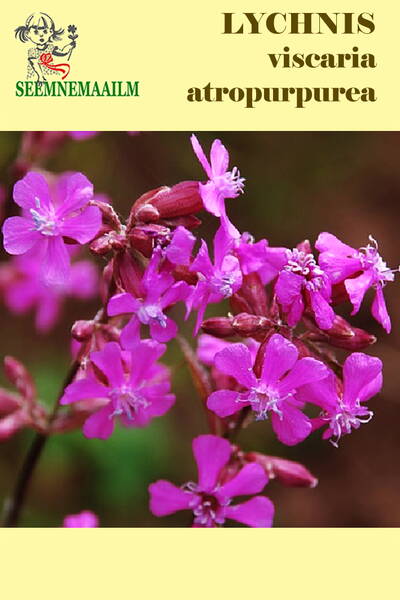Your shopping cart is empty!
Sticky Catchfly "Red Ball"
Lychnis viscaria ssp. atropurpurea
1.48€
Ex Tax: 1.20€
Ex Tax: 1.20€
Sticky сatchfly "Red Ball" - Lychnis viscaria ssp. atropurpurea.
An unpretentious perennial from the Caryophyllaceae family, 30 cm high.
The delicate petals of the star-shaped flowers, slightly wavy at the edges, will not stop shining throughout the summer. Flowering will last for many weeks, which will give the flowerbed extraordinary lightness. Due to its unpretentiousness, they grow wonderfully in borders and perfectly hold their shape during bad weather, tolerate a decrease in temperature without compromising the beauty of their inflorescences.
Blooms from the end of May for 45-50 days. The flowers are dark red, collected in large inflorescences.
Prefers well-lit areas, but can grow in partial shade. The soil should be moderately moist, without stagnant water. The crop responds to fertilizers.
Seeds are sown in late April - early May in open ground or before winter. 1,0 g = 14800 seeds.
Used for landscaping: in group plantings, borders, mixborders and for cutting.
Location: requires open, sunny places, although it also tolerates partial shade. In Estonia, it is often grown as a biennial. Overwinters without shelter.
Soil: undemanding to soil, but prefers loose, permeable, moist soil and a sunny location.
Reproduction: sowing seeds in March-April in greenhouses or in open ground before winter. Young plants are planted in a permanent place in spring or autumn, maintaining a distance of 15-20 cm between plants.
Seeds require preliminary stratification: sow the seeds on the soil surface, moisten with a spray bottle, cover with glass and place in the refrigerator (temperature +5+7 °C). Crops are kept in such conditions for 14 days, then transferred to room conditions. It is necessary to monitor the humidity of crops and ventilation. At a temperature of +18+20 °C, shoots appear on the 15-30th day. After the appearance of the first two true leaves, seedlings are pricked out.
Also propagated by dividing the bush and cuttings.
Flowering: June-August in the second year.
An unpretentious perennial from the Caryophyllaceae family, 30 cm high.
The delicate petals of the star-shaped flowers, slightly wavy at the edges, will not stop shining throughout the summer. Flowering will last for many weeks, which will give the flowerbed extraordinary lightness. Due to its unpretentiousness, they grow wonderfully in borders and perfectly hold their shape during bad weather, tolerate a decrease in temperature without compromising the beauty of their inflorescences.
Blooms from the end of May for 45-50 days. The flowers are dark red, collected in large inflorescences.
Prefers well-lit areas, but can grow in partial shade. The soil should be moderately moist, without stagnant water. The crop responds to fertilizers.
Seeds are sown in late April - early May in open ground or before winter. 1,0 g = 14800 seeds.
Used for landscaping: in group plantings, borders, mixborders and for cutting.
Location: requires open, sunny places, although it also tolerates partial shade. In Estonia, it is often grown as a biennial. Overwinters without shelter.
Soil: undemanding to soil, but prefers loose, permeable, moist soil and a sunny location.
Reproduction: sowing seeds in March-April in greenhouses or in open ground before winter. Young plants are planted in a permanent place in spring or autumn, maintaining a distance of 15-20 cm between plants.
Seeds require preliminary stratification: sow the seeds on the soil surface, moisten with a spray bottle, cover with glass and place in the refrigerator (temperature +5+7 °C). Crops are kept in such conditions for 14 days, then transferred to room conditions. It is necessary to monitor the humidity of crops and ventilation. At a temperature of +18+20 °C, shoots appear on the 15-30th day. After the appearance of the first two true leaves, seedlings are pricked out.
Also propagated by dividing the bush and cuttings.
Flowering: June-August in the second year.
Eng.: Sticky Catchfly. Bot. syn.: Silene atropurpurea, Viscaria viscosa Asch.












